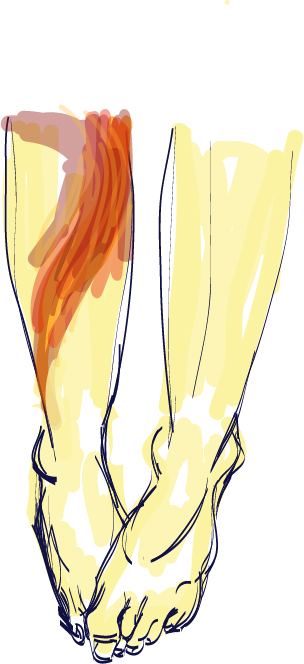
How to Treat a Burn
I recently came across a study that shows men are more likely to appear attractive to women if they have facial scars. I didn’t buy it when I first heard about it. On one hand, I detested how there was no mention of how it might work the other way around—how a woman’s allure might increase if she had scars on her face. On the other, my curiosity left me wondering to what extent I succumbed to this strange sexual phenomenon myself.
I considered scars to be the greatest badge of honor—a physical representation of triumph over adversity. That was enough to convince me that a scar could somehow boost my own status. All the great athletes, I imagined, had scars from long training sessions and sports injuries galore. I figured it was about time for me to earn some of my own. As it turns out, I was actually able to accomplish this in my sleep.
One March evening during my sophomore year of high school, I came home from fencing practice at around 8 p.m. It was the middle of the season for the girls’ fencing team, and my body was just getting used to the shifts in circadian rhythm. I was becoming worn out. I was running on low steam, barely accumulating three hours of sleep a night, and pushing through 12-hour school days.
All of this is to say that I can try to understand why I did what I did, but it still doesn’t fully make sense to the average person. That evening, after I had showered and scraped together some food for dinner, I sat at my desk like I did every night, forcing myself to tackle the monstrous essays that I hadn’t written and readings that I had fallen too far behind on—right next to the radiator heater I kept in my room. (My house perpetually felt like a tundra in the winter, so my family needed all the extra heating we could get.) Before I knew it, I slipped into a heavy slumber, somehow missing the fact that my leg was leaning directly against the heater. A massive blister cropped up just off of my left knee, and I acquired a gigantic scar—two inches of darkened skin.
I swore to myself that I would never fall asleep next to a radiator again.
I was one of those lucky adolescents who wasn’t cursed with rampant acne or eczema when I hit puberty. But I did end up making frequent trips to the dermatologist after the incident. Ever since I received that burn on my left leg, my mother has bugged the dermatologist into prescribing me Mederma scar gel, which would, in theory, accelerate my scar’s fading. I say “in theory” because I don’t know if it would have worked: I would constantly “forget” to use the gel. Secretly, I wanted to allow the wound to heal on its own.
The thing is, I wasn’t too bothered by this new mark that I had. It wasn’t my first burn scar either—I already had one that stretched across my left hand, the residue of an accident with a clothing iron that happened when I was a lot younger. I knew what it was like to live with unusual marks. One might say that I learned to accept the burns as a natural extension of my body.
But my mother didn’t. After that scar was etched onto my leg, she fretted that my life was “ruined,” that I had destroyed all chances of becoming the next Miss Korea. (This was not something I had considered doing anyway).
My mother’s obsession with my skin is embedded in Korean culture. With the rise of Korean skincare products, plastic surgery, and skin whitening treatments came an ideal of perfect skin that my scar interrupted. One dispute over a scar led to another, and then it became all about the stretch marks on my hips, the rashes on my arms, the bumps on my neck—the list goes on.
For two weeks after the radiator incident, I showed up to school wearing baggy sweatpants so I wouldn’t irritate the burn, per my doctor’s recommendation. My injury forced me to sit on the sidelines while the rest of my teammates dueled during fencing practice. I was treated like I was handicapped, for bones that weren’t even broken, for legs that could still lunge if I wanted them to. I became trapped by the silence of feeling left out of the circle—the circle of fortunate individuals with unscathed skin.
There are stories embedded in the marks on my body, but not everybody asks. I don’t think that I have to keep them hidden forever, though.
—Magazine writer Hayoung E. Ahn can be reached at hayoung.ahn@thecrimson.com. Follow her on Twitter @HayoungAhn.


